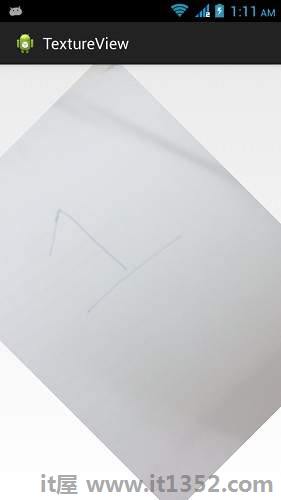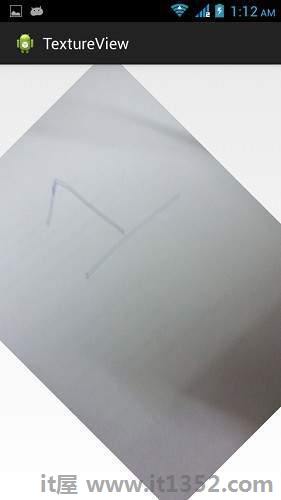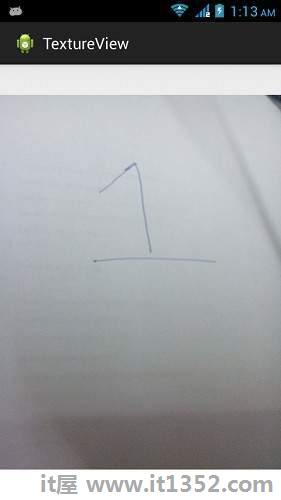如果要显示实时视频流或任何内容流(如视频或OpenGL场景),可以使用android提供的TextureView进行此操作.
按顺序要使用TextureView,您需要做的就是获取SurfaceTexture.然后可以使用SurfaceTexture渲染内容.为此,您只需要实例化此类的对象并实现SurfaceTextureListener接口.它的语法在下面给出 :
private TextureView myTexture;
public class MainActivity extends Activity implements SurfaceTextureListener{
protected void onCreate(Bundle savedInstanceState) {
myTexture = new TextureView(this);
myTexture.setSurfaceTextureListener(this);
setContentView(myTexture);
}
}之后,您需要做的是覆盖其方法.这些方法列出如下 :
@Override
public void onSurfaceTextureAvailable(SurfaceTexture arg0, int arg1, int arg2) {
}
@Override
public boolean onSurfaceTextureDestroyed(SurfaceTexture arg0) {
}
@Override
public void onSurfaceTextureSizeChanged(SurfaceTexture arg0, int arg1,int arg2) {
}
@Override
public void onSurfaceTextureUpdated(SurfaceTexture arg0) {
}可以旋转纹理视图中显示的任何视图,并使用 setAlpha 和 setRotation 方法调整其alpha属性.它的语法在下面和下面给出;
myTexture.setAlpha(1.0f); myTexture.setRotation(90.0f);
除了这些方法之外,TextureView类还有其他方法可用.它们列在下面和下面;
| Sr.No | 方法&描述 |
|---|---|
| 1 | getSurfaceTexture () 此方法返回此视图使用的SurfaceTexture. |
| 2 | getBitmap(int width,int height) 此方法返回返回相关曲面纹理内容的位图表示. |
| 3 | getTransform(Matrix transform) 此方法返回与此纹理视图关联的变换. |
| 4 | isOpaque() 此方法指示此视图是否不透明. |
| 5 | lockCanvas() 此方法开始编辑曲面中的像素 |
| 6 | setOpaque(boolean opaque) 此方法表示r这个TextureView的内容是不透明的. |
| 7 | setTransform(Matrix transform) 此方法将变换设置为与此纹理视图关联. |
| 8 | unlockCanvasAndPost(Canvas canvas) 此方法完成编辑曲面中的像素. |
下面的示例演示了TextureView类的用法.它包含一个基本应用程序,允许您在纹理视图中查看相机并更改其角度,方向等.
要试验此示例,您需要在实际的设备上运行它相机存在.
| 步骤 | 描述 |
|---|---|
| 1 | 您将使用android studio IDE创建Android应用程序在com.example.textureview包下将其命名为TextureView. |
| 2 | 修改src/MainActivity.java文件以添加活动代码. |
| 3 | 修改布局XML文件res/layout/activity_main.xml如果需要,添加任何GUI组件. |
| 5 | 运行应用程序并选择正在运行的Android设备并在其上安装应用程序并验证结果. |
以下是 src/c的内容om.example.textureview/MainActivity.java .
package com.example.textureview;
import java.io.IOException;
import android.annotation.SuppressLint;
import android.app.Activity;
import android.graphics.SurfaceTexture;
import android.hardware.Camera;
import android.os.Bundle;
import android.view.Gravity;
import android.view.Menu;
import android.view.TextureView;
import android.view.TextureView.SurfaceTextureListener;
import android.view.View;
import android.widget.FrameLayout;
public class MainActivity extends Activity implements SurfaceTextureListener {
private TextureView myTexture;
private Camera mCamera;
@SuppressLint("NewApi")
@Override
protected void onCreate(Bundle savedInstanceState) {
super.onCreate(savedInstanceState);
setContentView(R.layout.activity_main);
myTexture = new TextureView(this);
myTexture.setSurfaceTextureListener(this);
setContentView(myTexture);
}
@Override
public boolean onCreateOptionsMenu(Menu menu) {
// Inflate the menu; this adds items to the action bar if it is present.
getMenuInflater().inflate(R.menu.main, menu);
return true;
}
@SuppressLint("NewApi")
@Override
public void onSurfaceTextureAvailable(SurfaceTexture arg0, int arg1, int arg2) {
mCamera = Camera.open();
Camera.Size previewSize = mCamera.getParameters().getPreviewSize();
myTexture.setLayoutParams(new FrameLayout.LayoutParams(
previewSize.width, previewSize.height, Gravity.CENTER));
try {
mCamera.setPreviewTexture(arg0);
} catch (IOException t) {
}
mCamera.startPreview();
myTexture.setAlpha(1.0f);
myTexture.setRotation(90.0f);
}
@Override
public boolean onSurfaceTextureDestroyed(SurfaceTexture arg0) {
mCamera.stopPreview();
mCamera.release();
return true;
}
@Override
public void onSurfaceTextureSizeChanged(SurfaceTexture arg0, int arg1,
int arg2) {
// TODO Auto-generated method stub
}
@Override
public void onSurfaceTextureUpdated(SurfaceTexture arg0) {
// TODO Auto-generated method stub
}
}以下是 activity_main.xml的内容
<?xml version="1.0" encoding="utf-8"?> <RelativeLayout xmlns:android="http://schemas.android.com/apk/res/android" xmlns:tools="http://schemas.android.com/tools" android:layout_width="match_parent" android:layout_height="match_parent" android:paddingBottom="@dimen/activity_vertical_margin" android:paddingLeft="@dimen/activity_horizontal_margin" android:paddingRight="@dimen/activity_horizontal_margin" android:paddingTop="@dimen/activity_vertical_margin" tools:context=".MainActivity" > <TextureView android:id="@+id/textureView1" android:layout_width="wrap_content" android:layout_height="wrap_content" android:layout_alignParentTop="true" android:layout_centerHorizontal="true" /> </RelativeLayout>
以下是 AndroidManifest.xml的默认内容
<?xml version="1.0" encoding="utf-8"?> <manifest xmlns:android="http://schemas.android.com/apk/res/android" package="com.example.textureview" > <uses-permission android:name="android.permission.CAMERA"/> <application android:allowBackup="true" android:icon="@drawable/ic_launcher" android:label="@string/app_name" android:theme="@style/AppTheme" > <activity android:name="com.example.textureview.MainActivity" android:label="@string/app_name" > <intent-filter> <action android:name="android.intent.action.MAIN" /> <category android:name="android.intent.category.LAUNCHER" /> </intent-filter> </activity> </application> </manifest>
[object Object]

选择您的移动设备作为选项,然后检查您的移动设备,该设备将显示以下屏幕.此屏幕的alpha属性设置为 0.5 ,旋转设置为 45.

此屏幕的alpha属性设置为 1.5 ,旋转设置为 45 .

此屏幕的alpha属性设置为 1.0 和旋转设置为 90 .
